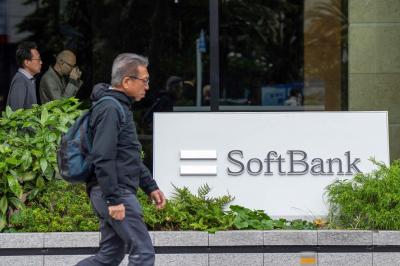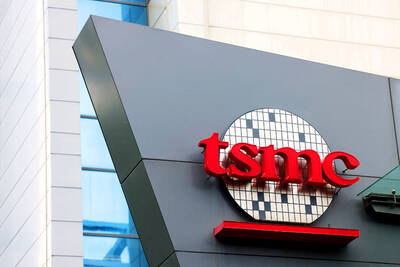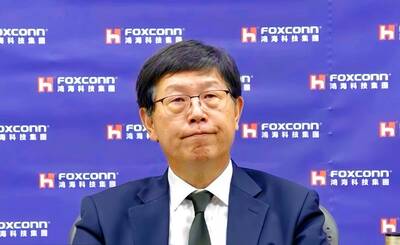A New York collector made 63 times his cost on a Chinese painting at a London auction yesterday, showing how money is being made by betting on trends in the contemporary art markets.
Howard Farber said he paid US$25,000 in 1996 for Wang Guangyi's (王廣義) Great Criticism: Coca-Cola, which portrays revolutionary soldiers stabbing at a Coca-Cola Co logo. It took ?780,000 (US$1.59 million) before commission at Phillips de Pury & Co, compared with a ?600,000 top estimate.
The buyer was Larry Warsh, a New York-based collector and art adviser who is Farber's son-in-law.
The political pop artist's 1993 critique of US consumer culture is "the most reproduced image of Chinese contemporary art," Farber, 65, a former real-estate financier, said before the sale.
"The artist sees the Coca-Cola logo as an invasion of Western brands into China, and every story in any magazine or book about Chinese art would probably use this image," he said.
"It's a lot of money," Warsh said in an interview.
It was the most he had ever paid for Chinese contemporary art.
"I am very nervous. Part of my plan is to create a traveling collection and send it to Asia, and this is the key piece. Wang Guangyi is the Warhol of China. This piece is one of the most famous samples of his work and one of the earliest," he said.
Warsh said that he planned to sell some of his collection, which includes pieces by Jean-Michel Basquiat and Keith Haring, to focus on China.
The collector's decision shows that resources for many art buyers are finite, and purchases aren't always a sign that new money is coming into the market.
Phillips' sale is part of a five-day marathon of contemporary art sales estimated by auctioneers at as much as ?184 million. Sotheby's last night took in ?34.9 million, missing its ?40.4 million top estimate even after adding commissions, in a possible sign collectors are discounting some artworks after two months of turbulence in the financial markets.
Still, Yue Minjun's (
Sotheby's described Yue's 1995 painting, which was inspired by the 1989 crackdown on the Tiananmen Square protests in Beijing, as "arguably the artist's most vehement, candid and politically loaded work."
Recalling Francisco de Goya's The Third of May, 1808: The Execution of the Defenders of Madrid, it depicts figures pointing at others in a mock-execution, in front of a red wall that suggests Beijing's Forbidden City.
As China's economy grows, the country's art is captivating Western collectors. London's Charles Saatchi will open his new gallery with a Chinese contemporary show, and Belgium's Guy Ullens has built a Beijing museum. Farber's sales have enabled him to profit from a three-year boom in values and from the rules he applied to buying works since 1995.

Japanese technology giant Softbank Group Corp said Tuesday it has sold its stake in Nvidia Corp, raising US$5.8 billion to pour into other investments. It also reported its profit nearly tripled in the first half of this fiscal year from a year earlier. Tokyo-based Softbank said it sold the stake in Silicon Vally-based Nvidia last month, a move that reflects its shift in focus to OpenAI, owner of the artificial intelligence (AI) chatbot ChatGPT. Softbank reported its profit in the April-to-September period soared to about 2.5 trillion yen (about US$13 billion). Its sales for the six month period rose 7.7 percent year-on-year

CRESTING WAVE: Companies are still buying in, but the shivers in the market could be the first signs that the AI wave has peaked and the collapse is upon the world Taiwan Semiconductor Manufacturing Co (TSMC, 台積電) yesterday reported a new monthly record of NT$367.47 billion (US$11.85 billion) in consolidated sales for last month thanks to global demand for artificial intelligence (AI) applications. Last month’s figure represented 16.9 percent annual growth, the slowest pace since February last year. On a monthly basis, sales rose 11 percent. Cumulative sales in the first 10 months of the year grew 33.8 percent year-on-year to NT$3.13 trillion, a record for the same period in the company’s history. However, the slowing growth in monthly sales last month highlights uncertainty over the sustainability of the AI boom even as

AI BOOST: Next year, the cloud and networking product business is expected to remain a key revenue pillar for the company, Hon Hai chairman Young Liu said Manufacturing giant Hon Hai Precision Industry Co (鴻海精密) yesterday posted its best third-quarter profit in the company’s history, backed by strong demand for artificial intelligence (AI) servers. Net profit expanded 17 percent annually to NT$57.67 billion (US$1.86 billion) from NT$44.36 billion, the company said. On a quarterly basis, net profit soared 30 percent from NT$44.36 billion, it said. Hon Hai, which is Apple Inc’s primary iPhone assembler and makes servers powered by Nvidia Corp’s AI accelerators, said earnings per share expanded to NT$4.15 from NT$3.55 a year earlier and NT$3.19 in the second quarter. Gross margin improved to 6.35 percent,

FAULTs BELOW: Asia is particularly susceptible to anything unfortunate happening to the AI industry, with tech companies hugely responsible for its market strength The sudden slump in Asia’s technology shares last week has jolted investors, serving as a stark reminder that the world-beating rally in artificial intelligence (AI) and semiconductor stocks might be nearing a short-term crest. The region’s sharpest decline since April — triggered by a tech-led sell-off on Wall Street — has refocused attention on cracks beneath the surface: the rally’s narrow breadth, heavy reliance on retail traders, and growing uncertainty around the timing of US Federal Reserve interest-rate cuts. Last week’s “sell-off is a reminder that Asia’s market structure is just more vulnerable,” Saxo Markets chief investment strategist Charu Chanana said in